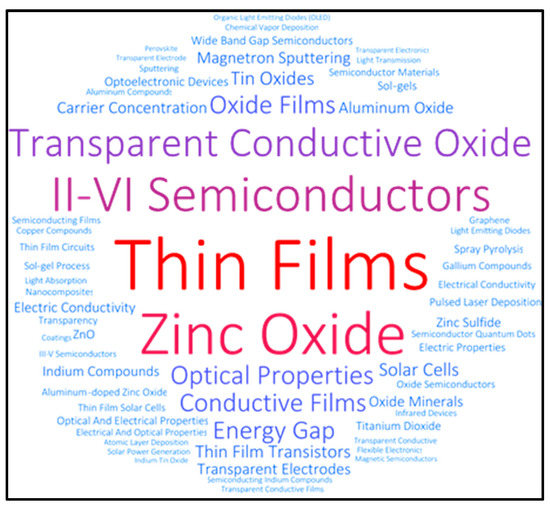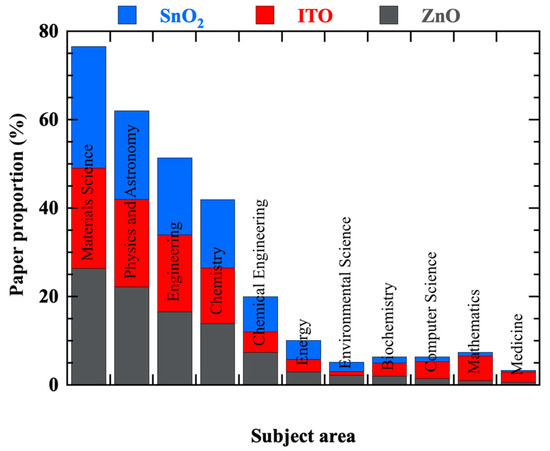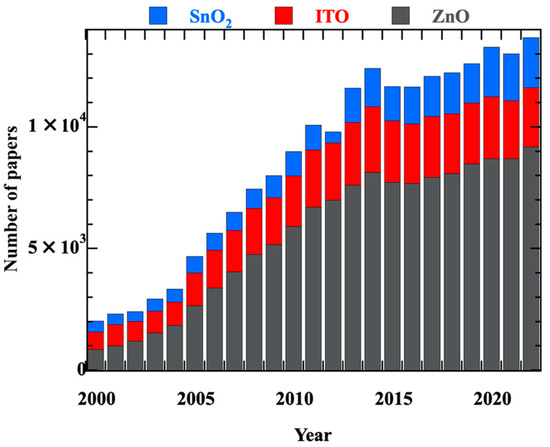There are many areas of application in everyday life where a thin film (from a few nanometers to a few micrometers) of conductive or semiconductive oxide substantially modifies the chemical, optical, electrical, thermal, catalytic, mechanical and surface properties of the substrate it covers. This is the case of transparent conductive oxides (TCO) whose development has significantly accelerated in the last two decades. Through this Editorial we will give an overview of this family of materials, their properties, their importance, the main historical steps, the main materials and application areas, as well as the challenges of future research.
The particular properties of transparent conductive oxides have paved the way for their integration into numerous sensors covering a wide range of applications. As a result, the TCO market is expected to grow significantly over the next few years with an annual growth rate between 9% and 16%, to reach a market size ranging between 1 to 5 billion USD, according to different sources [1]. This growth is attributed to the increasing demand for smartphones, tablet PCs, touch screens, and the need for solar panels with the gradual adoption of renewable energy.
Two properties characterize these materials: visibly transparency combined with good electrical conductivity. These two properties have particularly interested researchers in the functionalization of these materials in the form of thin films. Transparency in the visible range implies an optical gap of more than 3.1 eV for a semiconductor. Electrical conductivity can be achieved by doping the semiconductor to provide the necessary excess charge carriers with the necessary mobility. However, the requirement of both transparency and electrical conductivity are, a priori, antinomic from a physical point of view. Indeed, a conductive material tends to be opaque such as a metal, even if, at a submicronic thickness or in the form of nanowires, a metal can present a certain transparency. Similarly, a material that is visibly transparent, such as a glass or polymer, tends to be insulating. One can, hence, easily understand why this family of materials is of specific interest.
The wide range of TCOs include different metal oxides, involving one or more atoms of a metal of different metals and oxygen atoms, hence the name TCO. Indeed, the first mention of materials both transparent and conductive dates back to the beginning of the 20th century and concerned metal oxides (PbO, Cu2O and CdO) [2]. However, it was not until the 1980s that the interest in TCOs sky rocketed with the advent of new technologies and the democratization of flat screens and solar panels. Two main TCO materials were at the origin of this advent, tin oxide (SnO2) and, especially, tin-doped indium oxide (In2O3: Sn or ITO). However, the scarcity of indium and its soaring price opened the way to the search for new materials, including ZnO, a II-VI semiconductor that is much more abundant and, above all, non-toxic. As most of the performant TCO materials are n-type semiconductors, the motivation to search for a p-type TCO necessary for the development of transparent electronics [3] has reinforced the interest in ZnO.
We have evaluated the growing interest in these materials, especially in the last two decades, through the results of a literature search performed in Scopus [4] at the end of 2022, on the topic “transparent semiconductor films”. The world cloud linked to this bibliographic search (Figure 1) gives a quick and global overview of the subject, highlighting the materials that have been most studied, the methods that have been used to elaborate them, the properties that have most interested the authors of these works, and finally the applications for which these materials were particularly intended. The keywords reveal the wide range of metal oxides and confirm the place for the choice of ZnO in this research.

Figure 1.
Main keywords of the bibliographic research on the topic “transparent semiconductor films” [4].
Figure 1 also shows that these materials can be obtained in the form of thin films by different techniques, either soft chemistry methods such as the sol-gel process or spray pyrolysis, or by chemical or physical vapor deposition-based methods (plasma enhanced chemical vapor deposition (CVD), atomic layer deposition, pulsed laser deposition, sputtering, etc.). Their final properties of the TCO depend, among others, on its stoichiometry, doping, microstructure, morphology, crystallinity, and thickness. The choice of the material and the method of elaboration are determined by the targeted application. The chosen deposition technique is generally adapted to the nature, size and shape of the substrate. Thus, different properties may be preferred, according to the targeted application: transparency, conductivity, work function, mechanical durability, chemical durability, etchability, and hydrogen plasma resistance. In addition to the cost considerations, ecological and environmental concerns reinforce the need for less toxicity and lower energy elaboration.
Figure 2 compares the publications devoted to the three main TCOs that have been studied over the last two decades. The interest reserved for ZnO is explained by its superior chemical stability, ease of elaboration (and thus cost efficiency) and non-toxicity. Moreover, the need for performing a p-type TCO has contributed to the increased interest in ZnO for the development of transparent electronics.

Figure 2.
Publications on the three most studied TCOs by different subject areas over the last two decades.
The papers identified over the last two decades on this topic cover a wide spectrum of subject areas (Figure 3). The areas of experimental research on TCOs are related to their intended applications. Materials science, physics, chemistry, engineering and energy remain the preferred fields of interest for their elaboration, and the study of their properties in relation with their applications such as touch screens, photovoltaic panels and LED displays [5,6]. The field of possible applications has recently expanded to include environmental concerns. Indeed, the sensitivity of the electrical properties of a TCO in contact with chemicals makes it an excellent building block for a gas detector [7]. The direct or indirect application of TCOs in the photocatalysis for water treatment is also rapidly expanding [8]. In the field of photovoltaic research, where TCOs have been used since the 1980s in thin-film technology, perovskites seem to be a promising alternative to traditional TCOs [9].

Figure 3.
Number of publications devoted to each of the three most studied TCOs over the last two decades.
Papers related to computer science and mathematics are devoted to computational efforts to evaluate and predict properties (transparency, concentration and mobility of charge carriers) in order to direct research towards the most promising materials [10]. Other more unusual fields such as biochemistry and medicine are related to the potential biomedical applications. The conductive and transparency properties of TCOs contribute to making certain sensors more efficient and certain implants more comfortable for patients [11,12].
Emerging applications, such as flexible electronics and transparent displays, is driving the development of new generations of TCOs. The development of new less expensive TCO materials with similar or better properties compared to existing materials is an important area of research However, this development still faces several challenges. Optimizing TCO properties according to targeted applications remains an important challenge. Cost efficiency is a permanent objective. The main lever for this is the advancement of manufacturing techniques for the large-scale production of TCOs at a lower cost compared to the traditional fabrication methods. Finally, sustainable and environmentally friendly TCO production is an important issue for their long-term viability and wider use. Developing new TCO materials that have a lower toxicity, are less resource-intensive (with earth-abundant materials, such as Cu2O, Fe2O3, and Cr2O3), and more easily recyclable is a key area of research.
Conflicts of Interest
The authors declare no conflict of interest.
References
- Transparent Conducting Oxide (TCO). Glass Market 2023 Size and Share Estimations, Key Dynamics by Top Regions, Leading Players, Future Growth Insights, Key Strategies and Forecast to 2028; MarketWatch: New York, NY, USA, 2022. [Google Scholar]
- Baedeker, K. Über die elektrische Leitfähigkeit und die thermoelektrische Kraft einiger Schwermetallverbindungen. Ann. Der Phys. 1907, 327, 749–766. [Google Scholar] [CrossRef]
- Willis, J.; Scanlon, D.O. Latest directions in p-type transparent conductor design. J. Mater. Chem. C 2021, 9, 11995–12009. [Google Scholar] [CrossRef]
- Hadjadj, A.; Gilliot, M. (Unité de Recherche Matériaux & Ingénierie Mécanique (MATIM), Université de Reims Cham-pagne-Ardenne, 51100 Reims, France). Bibliographic research carried out on Scopus with the key words “Transparent semi-conductor thin films”. 2022. [Google Scholar]
- Rozati, S.M.; Ziabari, S.A.M. A review of various single layer, bilayer, and multilayer TCO materials and their applications. Mater. Chem. Phys. 2022, 292, 126789. [Google Scholar] [CrossRef]
- Musztyfaga-Staszuk, M.; Czupryński, A.; Radev, R. Review of the Chosen Methods of Producing Front Contacts to Transparent Conductive Oxides Layers in Photovoltaic Structures. Energies 2022, 15, 9026. [Google Scholar] [CrossRef]
- Macco, B.; Kessels, W.M.M. Atomic layer deposition of conductive and semiconductive oxides. Appl. Phys. Rev. 2022, 9, 041313. [Google Scholar] [CrossRef]
- Fang, Y.; Commandeur, D.; Lee, W.C.; Chen, Q. Transparent conductive oxides in photoanodes for solar water oxidation. Nanoscale Adv. 2020, 2, 626–632. [Google Scholar] [CrossRef] [PubMed]
- Xu, Y.; Lin, Z.; Wei, W.; Hao, Y.; Liu, S.; Ouyang, J.; Chang, J. Recent Progress of Electrode Materials for Flexible Perovskite Solar Cells. Nano-Micro Lett. 2022, 14, 117. [Google Scholar] [CrossRef] [PubMed]
- Oba, F.; Kumagai, Y. Design and exploration of semiconductors from first principles: A review of recent advances. Appl. Phys. Express 2018, 11, 060101. [Google Scholar] [CrossRef]
- Wang, T.; Lu, K.; Xu, Z.; Lin, Z.; Ning, H.; Qiu, T.; Yang, Z.; Zheng, H.; Yao, R.; Peng, J. Recent developments in flexible transparent electrode. Crystals 2021, 11, 511. [Google Scholar] [CrossRef]
- Cho, Y.U.; Lim, S.L.; Hong, J.-H.; Yu, K.J. Transparent neural implantable devices: A comprehensive review of challenges and progress. npj Flex. Electron. 2022, 6, 53. [Google Scholar] [CrossRef]
Disclaimer/Publisher’s Note: The statements, opinions and data contained in all publications are solely those of the individual author(s) and contributor(s) and not of MDPI and/or the editor(s). MDPI and/or the editor(s) disclaim responsibility for any injury to people or property resulting from any ideas, methods, instructions or products referred to in the content. |
© 2023 by the authors. Licensee MDPI, Basel, Switzerland. This article is an open access article distributed under the terms and conditions of the Creative Commons Attribution (CC BY) license (https://creativecommons.org/licenses/by/4.0/).